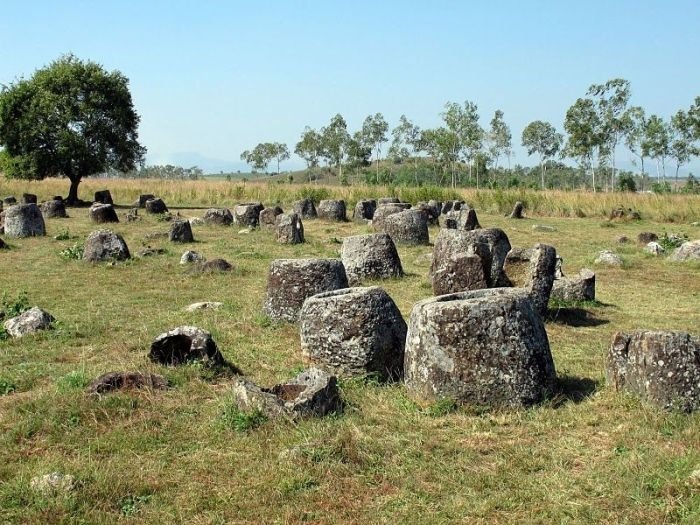|
|
The Plain Of Jars, Laos
|
More than 90 sites are known within the province of Xieng Khouang. Each site ranges from 1 up to 400 stone jars. The jars vary in height and diameter between 1 and 3 metres and are all without exception hewn out of rock. The stone jars are undecorated with the exception of a single jar at Site 1. This jar has a human bas-relief carved on the exterior. Parallels between this ‘frogman’ at Site 1 and the rock painting at Huashan in Guanxi, China have been drawn. The paintings which depict large full-frontal humans with arms raised and knees bent, are dated to 500 BCE - 200 CE .
From the fact that most of the jars have lip rims, it is presumed that all stone jars supported lids, although few stone lids have been recorded; this may suggest that the bulk of lids have been fashioned from perishable materials. Stone lids with animal representations have been noticed at few sites such as Ban Phakeo (Site 52). The bas-relief animals are thought to be monkeys, tigers and frogs. No in situ lid has ever been found.
Not to be confused with stone lids are the stone discs. The stone discs have at least one flat side and are grave markers which were placed on the surface to cover or mark a burial pit. These gravemarkers appear more infrequently than stone jars, but are found in close proximity. Similar are stone gravemarkers; these stones are unworked, but have been placed intentionally to mark a grave. To the north of Xieng Khouang and extensive network of intentionally placed largely unworked stones marking elaborate burial pits and chambers are known as ‘standing stones of Huaphan’. These following the investigations by Colani were dated to the Bronze Age. Material associated with the stone grave markers in Xieng Khouang however, is similar to the stone jars artefacts.
The jars lie in clusters on the lower footslopes and mountain ridges of the hills surrounding the central plateau and upland valleys. Several quarry sites have been recorded usually close to the jar sites. Five rock types are known:sandstone, granite, conglomerate, limestone and breccia.
|
|









